![]()
![]()
![]()
Use LEFT and RIGHT arrow keys to navigate between flashcards;
Use UP and DOWN arrow keys to flip the card;
H to show hint;
A reads text to speech;
16 Cards in this Set
- Front
- Back

|
Pilgrimage to Cythera ca. 1717 Jean-Antoine Watteau - couples paired off in the countryside, seem to be coming from an island - theme of love - fete galante: gathering of aristocrats who do sexual experimentation allowable by masquerade - layer of melencholy because fun time is ending |
|

|
Gerisaint's Signboard 1721 Watteau - view into a shop selling paintings - shop is separate from the dirty outside world (escapism) - connoisseur: knowledgable and appreciating of good art. - women like trees, men like nudes - beauty of women is comparable to art - king portrait being put away (he is not very important) |
|
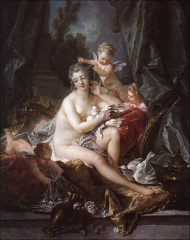
|
The Toilet of Venus 1751 Francois Boucher - Boucher was Madame de Pompadour's favorite artist. This painting isn't a portrait of her but a reference - satin curtains, smooth sensuous fabrics and warm skies refer to her body/sexuality |
|
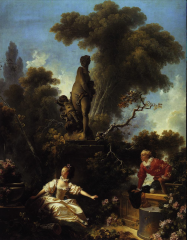
|
The Meeting from The Progress of Love (series) 1771-71 Jean-Honoré Fragonard - Mme. du Barry = last mistress of Louis XV - scene in garden where woman went to greet eager male, but stopping him - statue of venus, theme of love |
|
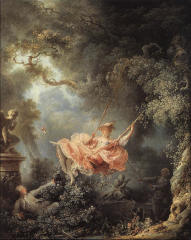
|
The Swing Fragonard 1767 - sculpture of cupid: finger to lips alludes to an affair, theme of love - old man behind (has to sit) while man in front is hidden in bushes - hazy background = feeling of intoxication |
|
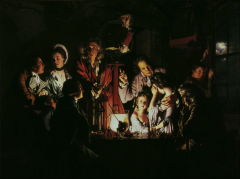
|
Experiment on a Bird in the Air Pump 1768 (Neo-Classical) Joseph Wright of Derby - lunar society: entrepreneurs promote science - Light = symbol of enlightenment - girls are distressed (emotion vs. ration) - Like caravagio but secular not religious |
|
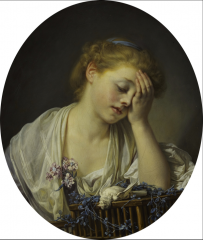
|
Girl with a Dead Bird 1765 (Neo-Classical) Jean-Baptiste Greuze - drooping flowers and dead bird = symbol of penis (and loss of virginity) - Diderot wrote a review, that was mean - close to viewer, young and distressed - sensuous, urge to console her "delicious melancholy" - genre: moral, everyday life, perils of love (18th cent = return to morality) |
|
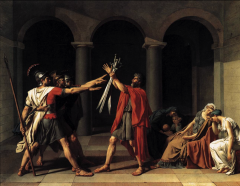
|
The Oath of the Horatii 1784 (Neo-Classical) Jaques-Louis David -rejection of Rococo: sharp and dark with clear message - commissioned by French government - David created this specific moment out of a tale: pact to fight to the death - political message: state > family - woman collapsed and curved, men strong and triangular - inspiration by Poussin (high ren. boroque) ... legible and dramatic |
|
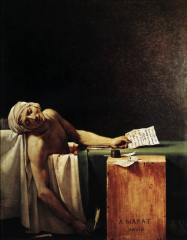
|
The Death of Marat 1793 Jaques-Louis David - French revolution: birth of democracy, death of 17,000 people - David is revolutionary, did portraits for others - Mata known for satire, was assassinated - Depicted as Christ-like (lamentation) and glamorized (ugly skin gone) >> propaganda |
|
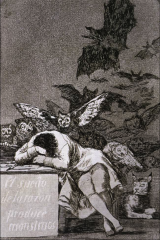
|
The Sleep of Reason Produces Monsters from Lost Capichos c 1799 (Romanticism) Francisco Goya - imagination is the root of an artist's creativity abandon reason, and in doing so, release demons - darkness (romantics) goes against enlightenment |
|
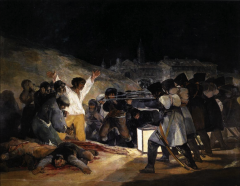
|
The Third of May 1808 (Romanticism) Francisco Goya - arrival of french in Spain (initially optimistic) - some were against it and had small uprising and french executed the Spaniards - French are unified and uniformed, like machine = symbolic of the state - main spanish man is christ-like (sacrifice) - lantern = failure of enlightenment, illuminates horrific scene |
|
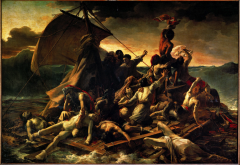
|
Raft of Medusa 1818-19 (Romanticism) Gericault - Historical- representing the real event: ship wrecks and not enough life jackets, build raft (149 people) - floated for 13 days and 15 survived - similar style to neo-classical but pessimistic (human condition) |
|
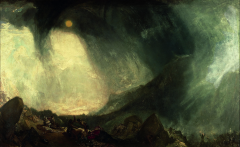
|
Snowstorm: Hannibal and his Army Crossing the Alps 1812 (Romanticism) Joseph Mallord Turner - Historical, not as literally represented - allegory of human ambition - transformed genre of landscape into history |
|

|
The Slave Ship Slavers Throwing Overboard the Dead and Dying - Typhoon Coming On 1840 (Romanticism) Joseph Mallor Turner - (compare with landscapes from N. Boroque) - slaveowner gets insurance for people lost at sea - hands and red in water... lacks clarity - so different that people thought artist went mad - Burke: sublime - terrifying awe, man vs. nature, strongest emotion |
|
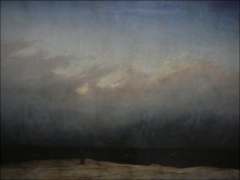
|
Monk By the Sea 1809-10 (Romanticism) Casper David Friedrich - Friedrich was protestant who used landscape to express mystical and spiritual: encounter with divine - painting part of pair with abbey |
|
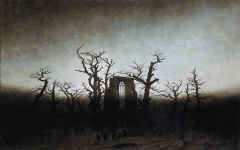
|
Abbey in the Oakwoods 1810 (Romanticism) Casper David Friedrich - clinging to faith through the end of the church as an institution - religion is primal, and rooted in nature. |

